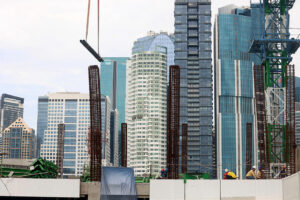ECONOMIC MANAGERS cut its gross domestic product (GDP) growth target for this year amid “heightened global uncertainties” arising from the Middle East conflict and US tariffs.
The Philippine economy is now expected to grow by 5.5-6.5% this year from the previous target of 6-8%, the Development Budget Coordination Committee (DBCC) said on Thursday.
It also narrowed the GDP growth target range to 6-7% for 2026 to 2028 from 6-8% previously, “reflecting a more measured and resilient outlook amid global headwinds.”
“The revisions take into account heightened global uncertainties, such as the unforeseen escalation of tensions in the Middle East and the imposition of US tariffs,” Budget Secretary Amenah F. Pangandaman, chair of the DBCC, said during a briefing.
“Despite these headwinds, the DBCC remains vigilant and ready to deploy timely and targeted measures to mitigate their potential impact on the Philippine economy,” she added.
The Philippine economy grew by a weaker-than-expected 5.4% in the first quarter from the 5.9% expansion a year ago.
Department of Economy, Planning, and Development Secretary Arsenio M. Balisacan said GDP has to grow by 5.5-6.5% to reach the low end of the target this year.
The DBCC also tweaked some macroeconomic assumptions on inflation, trade, crude oil and foreign exchange rate.
The inflation assumption for 2025 was narrowed to 2%-3% from a previous outlook of 2%-4%. It kept the 2-4% inflation assumption for 2026 to 2028.
In the first five months, inflation has averaged 1.9%, slightly below the Bangko Sentral ng Pilipinas’ (BSP) 2-4% target range.
“Inflation will continue to be manageable, benign over the near term. Growth may moderate, but remain firm,” BSP Deputy Governor Zeno R. Abenoja said during the briefing.
OIL PRICESThe DBCC expects Dubai crude oil prices to average $60-$70 for this year until 2028 from $60-$80 previously, due to “easing global demand and expected increases in global oil inventories.”
However, Mr. Balisacan warned about the potential impact of a prolonged war in the Middle East.
“If those (oil price) increases persisted for the rest of the year, of course the economy would be badly hit as would be the economies of the rest of the world,” he told reporters.
Oil prices rose on Thursday after a sharp slump after the Israel-Iran ceasefire was announced. Reuters reported Brent crude futures rose 0.37% to $67.93 a barrel, while US West Texas Intermediate crude gained 0.45% to $65.21.
On the other hand, the foreign exchange is assumed to “remain stable” and average to P56-P58 per dollar from this year until 2028.
“This is supported by lower domestic inflation and will continue to be shaped by global financial conditions and external trade performance,” the DBCC said.
SLUGGISH TRADETrade is expected to be sluggish, reflecting the impact of the Trump administration’s tariff policy.
“Goods exports are projected to contract by 2% in 2025 (from a previous projection of 6% growth), largely due to slower global demand and heightened trade policy uncertainties, before recovering to a modest growth of 2% from 2026 to 2028,” DBCC said.
The DBCC also lowered the goods imports growth projection to 3.5% this year from 5% previously. Imports are projected to expand by 4% from 2026 to 2028 from 8% previously, “supported by stable domestic consumption and sustained infrastructure spending.”
US President Donald J. Trump announced higher reciprocal tariffs on most of the country’s trading partners, with Philippine goods facing the second-lowest rate in Southeast Asia at 17%. However, the reciprocal tariffs have been paused for 90 days until July 9. A baseline 10% tariff remains in place.
Special Assistant to the President for Investment and Economic Affairs Frederick D. Go said the Philippines continues to negotiate with the US on the tariffs, without giving details.
DEFICIT CEILINGMeanwhile, the DBCC now expects the budget deficit as a share of GDP to balloon to 5.5% this year from 5.3% previously. It also sees the deficit as a share of GDP to widen to 5.3% in 2026 from 4.7% previously.
The projected budget gap as a percentage of GDP for 2027 was raised to 4.8% from 4.1% previously, while for 2028, it was revised to 4.3% from 3.7% previously.
“We revised the medium-term fiscal program (MTFP) because when we originally first crafted the MTFP, these external factors were not yet taken into account. Like for instance, we already had a war in Ukraine and Russia. We already had another war in the Middle East and so many global uncertainties,” Finance Assistant Secretary Karlo Fermin S. Adriano said.
Economic managers also proposed a P6.793-trillion national budget for 2026, up 7.4% from 2025.
“The 2026 National Budget prioritizes human capital development by prioritizing investments in quality education, healthcare, and workforce upskilling,” the DBCC said. — with inputs from ARAI
